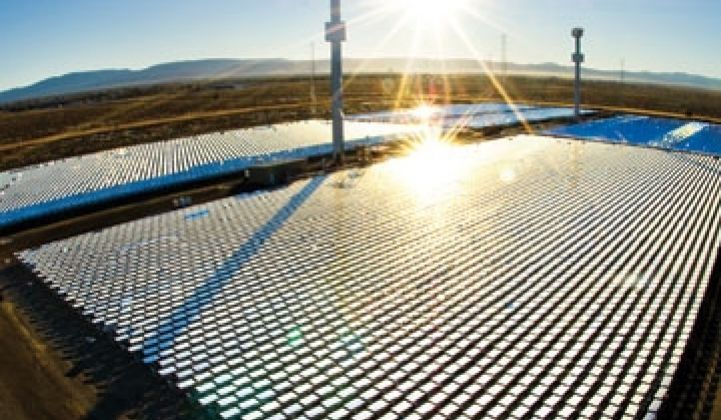The tower has landed.
Power towers – a solar thermal technology that is both cheaper and more efficient than the familiar parabolic mirror systems – will have their debut in the U.S. today when eSolar shows off its 5-megawatt Sierra SunTower solar thermal plant in Lancaster, California. The system consists of 24,000 mirrors and two towers and will feed power into Southern California Edison. The great unveiling takes place at 10 a.m. PT.
The company says it is first tower system in the U.S., but it won't be alone for long. BrightSource Energy has lined up contracts to install over 2 gigawatts (note--gigawatts, not megawatts) of tower systems in the Southwest (mostly California) over the next several years. Some towers are already in place in Israel and Spain.
eSolar earlier this year tweaked its business model. Initially, the company pursued contracts to build large thermal power plants. Financing, however, tightened Although Google had given eSolar money, Bill Gross stepped in as CEO and had to spend time searching for funds. At the same time, the large domestic utilities awarded their contracts to build large thermal plants to others, such as BrightSource, Solel and Stirling Energy Systems.
First Ausra, and then eSolar announced they would sell equipment to others trying to build power plants and try, potentially, to build power plants on their own on a future date.
So far, the strategy seems to be working better than the old one. In February, Princeton, N.J.-based NRG Energy bought the rights from eSolar to build 500 megawatts worth of solar-thermal power plants in the United States. NRG agreed to pay $10 million for the rights and a stake in eSolar. In March, India's Acme Group invested $30 million into eSolar and got a license to the technology.
What makes towers groovy? Mirrors called heliostats capture and then direct solar radiation onto a water-filled tank on a tower. The resulting steam is used to turn a turbine. The modular nature of the mirrors makes construction easier. Traditional trough systems employ more expensive curved mirrors that heat oil in a thin tube.
Tower/heliostats can also operate at higher temperatures, meaning more power.
"Higher temperature will win out and that could be tower in the long run," said Fred Morse, one of the country's experts on solar thermal, earlier this year.
Meanwhile, parabolic troughs aren't dead. Solar Millennium has signed contracts this year that could lead to 726 megawatts of trough power in the Southwest.
Image courtesy eSolar.



